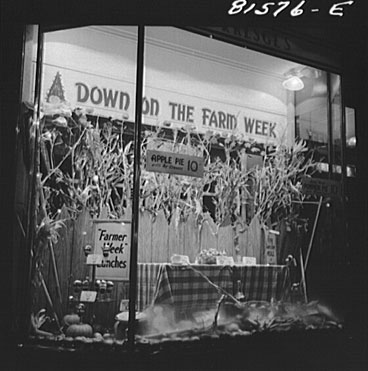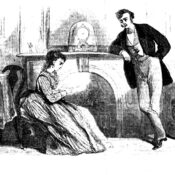The “five-and-ten store” officially departed the American landscape in 1997. That year, the F. W. Woolworth Company ended 118 years in the discount retail business.
In fact, the five-and-dime store had already passed away forty years earlier. As the Post reported it,
“The five-and-ten, as an American institution, came to a quiet end on November 13, 1935. The occasion was a meeting of the board of directors of the F. W. Woolworth Co. The action they took was designed to engineer the company into merchandising more profitably than the price-restricted field of five-and-ten.”
On that fateful day, the board passed the following resolution:
‘Resolved that the selling-price limit of twenty cents on merchandise be discontinued.’

It may surprise many Americans who grew up at five-and-ten stores that the store name wasn’t just meant to connote inexpensive merchandise. It was the store’s rigid pricing policy: a nickel or dime would buy any item in the store.
It’s just as surprising that the store could keep its shelves stocked only with 5¢ and 10¢ items for 55 years.
By the 1930s, though, the store had bowed to inflation by allowing 20¢ as the top price they could charge. Even this adjustment proved too restrictive. So Woolworth abandoned the five-and-dime policy. It proved a fortunate, if regretted, move. The Woolworth chain continued to prosper. As late as 1979, Woolworth, with its subsidiary Woolco, operated 800 stores, making it the largest department store chain in the world.
There was little indication of this future greatness when Frank Woolworth opened his Great Five Cent Store in Utica, New York. The idea had already proved itself in Michigan and western New York, where merchants had sold mass-produced, low-cost household goods in “nickel stores.”
In its 1940 series entitled “Dime Store,” the Post recorded the inventory at Frank Woolworth’s store when it opened on February 22, 1879. It included—
Toy dustpans. Tin pepper boxes. Drinking cups. Gravy strainers. Tin scoops. Purses. Biscuit cutters. Flour dredges. Schoolbook straps. Egg whips. Apple corers. Fire shovels. Boot blacking. Animal-shaped soap. Animal-shaped Cake Cutters. Candlesticks. Ladles. ABC plates [plates with the alphabet inscribed around the rim]. Scalloped pie plates. Baseballs. Cast-iron [cooking pot] cover lifters. Tack hammers. Writing books. Pencil charms. Shaving Lather brushes. Tin spoons. Police whistles. Pie plates. Red jewelry. Napkins, handkerchiefs, thread, and novelties.
On the evening before his scheduled opening, there was a knock at his store door. A woman was peering through the glass.
“The store isn’t open, madam.”
“I know what I want. I’ve read your circulars. I want a five-cent fire shovel.”
She was the first customer, and he served her without premonition of the vast tide of humanity which was to follow her.
Frank was young enough to see his Five Cent Stores become a nationwide chain. Thirty-four years after opening his first store, he moved into his office in the new Woolworth Building in New York City— the tallest building in the world (until surpassed by the Chrysler Building in 1930.)
One of the secrets for his success, Woolworth believed, was the attraction of five-cent and, eventually, ten-cent pricing.
Right after the Fourth of July in 1890, Woolworth complained: “One of the stores wrote me they sold firecrackers for 3 cents and some of the large ones at 15 cents per bunch, and, in my opinion, was all wrong, as it is getting off the idea of strictly 5 and 10 cents business— Stick to the original idea.”
Candy sales were particularly important to Woolworth’s success.
“I don’t pretend to know much about the candy business, but, in my opinion, if you want to make a big success of candy, put it in brass trays and put it up near the door, so that people can be reminded of it as they are passing out and take some home to the children. “
Woolworth believed that candy, alone, would pay the rent on each store.
Another reason for Woolworth’s success was a model that still works: importing goods from foreign markets with cheap labor. In the 1880s, this was Europe. On a buying trip in Germany, Woolworth noted,
It is no longer a mystery to me how they make dolls and toys so cheap, for most of it is done by women and children at their homes anywhere within 20 miles of this place. Some of the women in America think they have got hard work to do, but it is far different than the poor women here, that work night and day on toys, and strap them onto their backs, and go 10 or 20 miles through the mud with 75 pounds on their backs, to sell them. The usual price they get for a good 10-cent doll is about 3 cents each here, and they are obliged to buy the hair, shirts and other materials, to put them together, and they probably get about 1 cent each for the labor they put on them.
The streets here are filled with women with baskets on their backs filled with dolls and toys, and they walk in the middle of the street when the mud is ankle deep, in preference to the clean sidewalk. We saw a poor little girl that could not have been over four years old with a basket strapped on her back larger than herself, and Mr. Hunt asked her where she lived and she told us a place about five miles from here, and she came alone. We gave her some money and she looked at it as if she never saw any of it before. It is an ordinary thing here to see a dog and a woman hitched together or cows and women drawing a heavy load of goods.
While the “five-and-dime” store has gone, the principle is still very much alive. The nickel and dime of 1935, in today’s market, has the purchasing power of 75¢ and $1.50, which keeps hundreds of Everything-Costs-A-Dollar stores in operation.
Become a Saturday Evening Post member and enjoy unlimited access. Subscribe now



Comments
I really wish that we all could have prices like that now days
In 1938 when I was ten years old, about two weeks before Christmas, Dad would give me a dollar to do my Christmas shopping. I would go to the Woolworth Five and Dime store on Lancaster Avenue, in Philadelphia, PA
For Mom, I would purchase a box of powder and powder puff for 0.25 cents. For Dad, a wallet for 0.25 cents. For my three sisters, a fancy hanky and comb set for 0.15 cents each equaling 0.45 cents. Guess what, I had a nickel left over to buy me some candy.
Young Frank started with just one store,
And one idea how to sell –
Keep the price cheap and folks want more.
Hundreds of stores later would tell.
Frank ran his empire from within
Then tallest building in the world,
Built with millions from five and ten.
Selling success about him swirled.
Winfield Hall was his grand estate,
Showplace to his fortune and fame.
All in all not too bad a fate
For Frank – Woolworth was his last name.
Ol’ Frank got real rich over time,
Charging folks a nickel and dime.